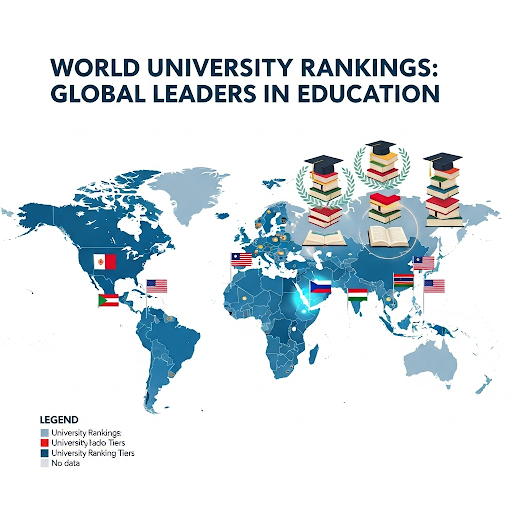The global landscape of higher education is a dynamic and competitive arena, where world university rankings serve as a critical benchmark for assessing academic excellence, research output, and institutional impact. These rankings provide students, educators, and policymakers with insights into which countries and institutions are leading the charge in delivering top-tier education. In this comprehensive article, we delve into the intricacies of world university rankings, explore the countries that consistently dominate these lists, and analyze the factors that position them at the forefront of global education. By examining methodologies, key performance indicators, and regional trends, we aim to offer a detailed guide to understanding which nations excel in fostering academic innovation and preparing students for a rapidly evolving world.
- Understanding World University Rankings
- Top Countries Leading in World University Rankings
- United States: The Powerhouse of Higher Education
- United Kingdom: A Legacy of Academic Excellence
- China: The Rising Star in Global Education
- Germany: Excellence in Research and Accessibility
- Australia: A Hub for International Students
- Emerging Players in World University Rankings
- Singapore: Asia’s Education Hub
- Canada: Inclusive and Innovative
- Switzerland: Precision and Excellence
- Netherlands: A Model of Accessibility
- Factors Driving Success in World University Rankings
- Challenges and Opportunities in Global Higher Education
- Recommendations for Students and Institutions
- FAQs
Understanding World University Rankings
World university rankings are meticulously crafted evaluations that assess higher education institutions based on a variety of metrics, including academic reputation, research output, teaching quality, international outlook, and industry collaboration. Prominent ranking systems such as the QS World University Rankings, Times Higher Education (THE) World University Rankings, and Academic Ranking of World Universities (ARWU)—also known as the Shanghai Rankings—provide a global perspective on institutional performance. These rankings are trusted by students, academics, and governments alike, offering a snapshot of the best universities worldwide and highlighting the countries that lead in education.
Each ranking system employs a unique methodology, but common themes emerge. For instance, the QS World University Rankings evaluate universities based on six key indicators: academic reputation, employer reputation, faculty/student ratio, citations per faculty, international faculty ratio, and international student ratio. Similarly, the THE World University Rankings use 18 performance indicators grouped into five areas: teaching, research environment, research quality, international outlook, and industry engagement. The ARWU, on the other hand, emphasizes research output, focusing on metrics like the number of Nobel Prize and Fields Medal winners, highly cited researchers, and publications in top-tier journals.
These methodologies ensure that rankings reflect a holistic view of institutional performance, capturing not only academic excellence but also global influence and societal impact. By analyzing these rankings, we can identify the countries that consistently produce world-class universities and understand the factors driving their success.
Top Countries Leading in World University Rankings
The world university rankings reveal a clear hierarchy of countries that dominate global higher education. The United States, the United Kingdom, China, Germany, and Australia are among the leaders, each excelling in distinct areas of academic and research performance. Below, we explore the key players in detail, highlighting their strengths, top institutions, and contributions to global education.
United States: The Powerhouse of Higher Education
The United States stands as the undisputed leader in world university rankings, with a higher education system renowned for its diversity, innovation, and research prowess. In the QS World University Rankings 2026, the Massachusetts Institute of Technology (MIT) retains its position as the top-ranked university globally, a title it has held for over a decade. Other U.S. institutions, such as Harvard University, Stanford University, and the California Institute of Technology (Caltech), consistently rank among the top 10, reflecting the country’s dominance.
The U.S. boasts 192 institutions in the QS World University Rankings 2026, with many showing improved positions due to their focus on sustainability, international collaboration, and cutting-edge research. The THE World University Rankings 2025 also highlight the U.S.’s strength, with institutions like Harvard, Stanford, and MIT leading in teaching, research quality, and industry engagement. The U.S. excels due to several key factors:
- Robust Funding: U.S. universities benefit from substantial public and private funding, enabling them to invest in state-of-the-art facilities, world-class faculty, and groundbreaking research.
- Research Output: The U.S. leads in research publications and citations, with institutions like Stanford and MIT producing high-impact studies in fields like artificial intelligence, biotechnology, and engineering.
- Global Reputation: American universities attract top talent from around the world, fostering a diverse academic environment that enhances their global influence.
- Industry Connections: Strong ties with industries, particularly in technology and healthcare, ensure that U.S. institutions remain at the forefront of innovation.
Notable U.S. universities include:
- Harvard University: Founded in 1636, Harvard is a global leader in disciplines like law, medicine, and social sciences, with a strong emphasis on interdisciplinary research.
- Stanford University: Located in Silicon Valley, Stanford drives innovation in technology and entrepreneurship, producing alumni like Elon Musk and Sergey Brin.
- MIT: Renowned for its STEM programs, MIT leads in research quality and industry collaboration, with significant contributions to fields like computer science and engineering.
Despite its strengths, the U.S. faces challenges, including high tuition costs and disparities in access to education. However, its ability to maintain a high number of top-ranked institutions solidifies its position as a global leader in education.
United Kingdom: A Legacy of Academic Excellence
The United Kingdom is a close contender in world university rankings, with a rich history of academic excellence and a reputation for producing world-class scholars. The THE World University Rankings 2025 crown the University of Oxford as the top university globally for the ninth consecutive year, a testament to its enduring legacy. Other UK institutions, such as Imperial College London, the University of Cambridge, and University College London (UCL), consistently rank among the top 10, showcasing the UK’s academic strength.
The UK’s success in world university rankings stems from its rigorous academic standards, historic institutions, and strong international outlook. Key factors include:
- Historic Prestige: Institutions like Oxford and Cambridge, with centuries of history, attract top students and faculty, enhancing their global reputation.
- Research Excellence: The UK excels in research environment and quality, with universities leading in fields like medicine, physics, and social sciences.
- Internationalization: The UK’s universities are highly diverse, with a significant proportion of international students and faculty, fostering a global academic community.
- Post-Study Opportunities: The UK’s two-year post-study work visa makes it an attractive destination for international students, particularly from India and other non-EU countries.
Notable UK universities include:
- University of Oxford: With a history dating back to 1096, Oxford excels in teaching, research, and international outlook, offering a wide range of programs across humanities and sciences.
- University of Cambridge: Founded in 1209, Cambridge is renowned for its contributions to science, literature, and economics, with 92 Nobel Prize affiliates.
- Imperial College London: A leader in STEM disciplines, Imperial ranks second globally in the QS World University Rankings 2026, driven by its focus on innovation and sustainability.
While the UK’s higher education sector faces challenges, such as declining reputations due to funding constraints, its universities remain global leaders, offering a blend of tradition and innovation.
China: The Rising Star in Global Education
China has emerged as a formidable player in world university rankings, with significant investments in higher education driving its ascent. In the QS World University Rankings 2026, Tsinghua University ranks 17th, while Fudan University climbs to 30th, reflecting China’s growing influence. The THE World University Rankings 2025 also highlight China’s progress, with institutions like Peking University and Tsinghua University leading in Asia.
China’s rise is fueled by several factors:
- Government Investment: Massive funding for research and infrastructure has transformed Chinese universities into global research hubs.
- Research Output: China leads in publication volume, particularly in STEM fields, with a growing number of highly cited researchers.
- International Collaboration: Partnerships with global institutions enhance China’s academic reputation and attract international talent.
- Focus on STEM: Chinese universities prioritize science, technology, engineering, and mathematics, aligning with global demand for technical expertise.
Notable Chinese universities include:
- Tsinghua University: A leader in engineering and computer science, Tsinghua is China’s top-ranked institution, known for its research output and global partnerships.
- Peking University: Renowned for its humanities and social sciences programs, Peking attracts top talent and produces influential research.
- Fudan University: With a strong focus on interdisciplinary research, Fudan excels in medicine, business, and international studies.
China’s rapid rise in world university rankings underscores its commitment to becoming a global education leader, though challenges like academic freedom and language barriers remain.
Germany: Excellence in Research and Accessibility
Germany is a powerhouse in European higher education, known for its research-intensive universities and accessible education system. In the QS World University Rankings 2026, Ludwig-Maximilians-Universität München and Technische Universität München rank among the top 100, reflecting Germany’s academic strength. The THE World University Rankings 2025 also highlight Germany’s contributions, with 49 institutions featured.
Germany’s success is driven by:
- Free Education: Most public universities offer tuition-free education, making higher education accessible to a diverse student population.
- Research Excellence: Germany’s universities lead in fields like engineering, physics, and chemistry, with strong industry ties.
- Internationalization: A growing number of English-taught programs attract international students, enhancing Germany’s global appeal.
- Innovation Ecosystem: Collaboration with industries, particularly in automotive and technology sectors, drives innovation and employability.
Notable German universities include:
- Ludwig-Maximilians-Universität München: A leader in research and humanities, LMU Munich is renowned for its contributions to science and medicine.
- Technische Universität München: TUM excels in engineering and technology, with strong industry partnerships and a focus on sustainability.
- Heidelberg University: One of Europe’s oldest universities, Heidelberg is a hub for medical and scientific research.
Germany’s commitment to accessibility and research excellence positions it as a leader in world university rankings, particularly in Europe.
Australia: A Hub for International Students
Australia is a global leader in higher education, particularly for international students, with a strong presence in world university rankings. The QS World University Rankings 2026 feature the University of Melbourne and the University of Sydney in the top 20, while the THE World University Rankings 2025 highlight Australia’s strength in teaching and research.
Australia’s success is attributed to:
- High-Quality Education: Australian universities offer rigorous academic programs and a student-centered approach.
- International Appeal: Generous post-study work visas and a welcoming environment attract students from Asia, Europe, and beyond.
- Research Innovation: Universities like the Australian National University lead in fields like environmental science and physics.
- Affordability: Compared to the U.S. and UK, Australia offers competitive tuition rates and scholarships for international students.
Notable Australian universities include:
- University of Melbourne: A leader in arts, humanities, and medical research, Melbourne is Australia’s top-ranked institution.
- Australian National University: Known for its research excellence, ANU excels in social sciences and public policy.
- University of Sydney: With a strong international outlook, Sydney is a hub for business, engineering, and health sciences.
Australia’s focus on internationalization and research makes it a top destination for students seeking a world-class education.
Emerging Players in World University Rankings
While the U.S., UK, China, Germany, and Australia dominate world university rankings, other countries are making significant strides. Singapore, Canada, Switzerland, and the Netherlands are emerging as key players, each contributing to the global higher education landscape.
Singapore: Asia’s Education Hub
Singapore’s National University of Singapore (NUS) ranks 8th in the QS World University Rankings 2026, making it Asia’s top university. NUS and Nanyang Technological University (NTU) excel in research, sustainability, and employer reputation, driven by Singapore’s strategic investments in education.
Canada: Inclusive and Innovative
Canada’s University of Toronto and McGill University rank among the top 30 in the QS World University Rankings 2026. Canada’s inclusive education system, affordable tuition, and post-study work opportunities make it a top destination for international students.
Switzerland: Precision and Excellence
Switzerland’s ETH Zurich ranks 7th in the QS World University Rankings 2026, known for its STEM programs and research output. The country’s focus on innovation and quality education positions it as a European leader.
Netherlands: A Model of Accessibility
The Netherlands’ Delft University of Technology and the University of Amsterdam rank highly, with a focus on research and internationalization. Tuition-free or low-cost education enhances the country’s appeal.
Factors Driving Success in World University Rankings
The countries leading in world university rankings share common attributes that contribute to their success. These include:
- Investment in Education: High levels of public and private funding enable universities to maintain cutting-edge facilities and attract top talent.
- Research Focus: Emphasis on high-impact research, measured by citations and publications, enhances global reputation.
- Internationalization: Diverse student and faculty populations foster global collaboration and innovation.
- Industry Collaboration: Partnerships with industries drive innovation and ensure graduates are job-ready.
- Policy Support: Government policies that prioritize education and research create a conducive environment for academic excellence.
Challenges and Opportunities in Global Higher Education
While leading countries excel in world university rankings, they face challenges such as rising tuition costs, equity in access, and adapting to technological advancements. Emerging economies, particularly in Asia and Africa, are investing heavily in education, signaling a shift toward a more multipolar higher education landscape.
Recommendations for Students and Institutions
To leverage world university rankings, we recommend the following:
- For Students:
- Research universities based on program relevance, international outlook, and post-study opportunities.
- Consider emerging destinations like Singapore and Canada for affordable, high-quality education.
- Explore scholarships and financial aid to offset costs.
- For Institutions:
- Invest in research and international collaboration to boost rankings.
- Enhance teaching quality and student support services.
- Prioritize sustainability and industry partnerships to align with global trends.
FAQs
- What are world university rankings?
World university rankings are evaluations of higher education institutions based on metrics like academic reputation, research output, and international outlook. - Which country leads in world university rankings?
The United States leads, with institutions like MIT, Harvard, and Stanford consistently ranking in the top 10. - What is the top university in the world in 2025?
The University of Oxford tops the THE World University Rankings 2025, while MIT leads the QS World University Rankings 2026. - Why does the U.S. dominate world university rankings?
The U.S. excels due to robust funding, high research output, global reputation, and strong industry ties. - Which UK universities are top-ranked?
Oxford, Cambridge, Imperial College London, and UCL are among the top-ranked UK universities. - How has China risen in world university rankings?
China’s rise is driven by government investment, research output, and international collaboration, with Tsinghua and Peking leading. - What makes Germany’s education system stand out?
Germany offers tuition-free education, research excellence, and strong industry connections. - Why is Australia popular for international students?
Australia’s high-quality education, post-study work visas, and affordability attract international students. - What is the top university in Asia?
The National University of Singapore (NUS) is Asia’s top university, ranking 8th in the QS World University Rankings 2026. - How are world university rankings calculated?
Rankings use metrics like academic reputation, research citations, faculty/student ratio, and international outlook. - What challenges do top-ranked countries face?
Challenges include high tuition costs, equity in access, and adapting to technological advancements. - Why is Singapore a rising star in education?
Singapore’s NUS and NTU excel in research, sustainability, and employer reputation, supported by strategic investments. - How does Canada perform in world university rankings?
Canada’s University of Toronto and McGill rank highly, with an inclusive and affordable education system. - What role does research play in rankings?
Research output, measured by citations and publications, significantly influences university rankings. - How can students use world university rankings?
Students can use rankings to choose universities based on program quality, international opportunities, and career prospects.




















